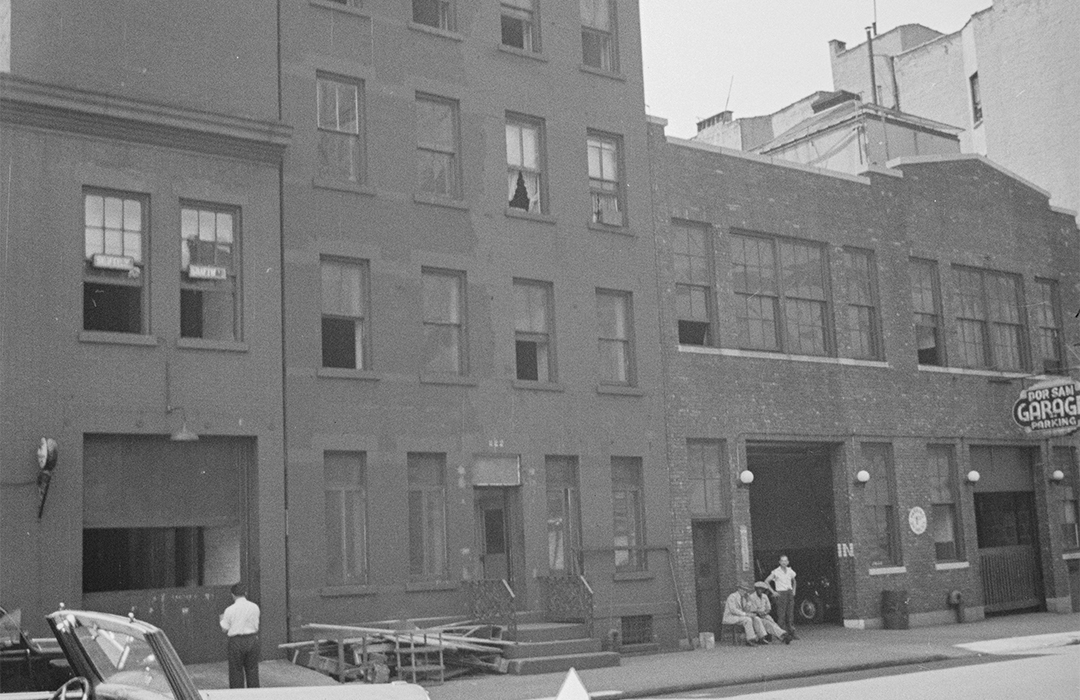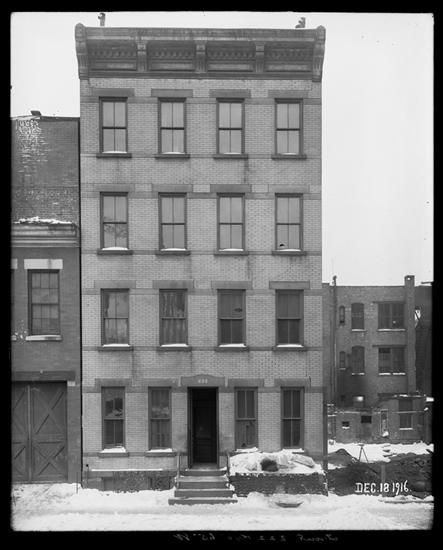
222 West 65th Street
by Tom Miller
Born in Germany, architect August H. Blankenstein immigrated to the United States in 1860 and began his practice in New York in 1872. He was a partner of Henry Herter in 1884 when he was hired by developer Henry Meyer to design a tenement building on West 65th Street between Amsterdam and West End Avenues. Completed the following year, 222 West 65th Street was faced in beige brick and trimmed in brownstone. Its neo-Grec design included stone bandcourses that connected the sills, and a pressed metal cornice.
Tenement buildings in the San Juan Hill neighborhood were filled with working class occupants. Many of the original tenants of 222 West 65th Street were German immigrants. Typical was the Wecker family, here by 1894. Living with the family was Annie Wecker’s widowed mother, Heidenig Schuebba. (It is possible that newspapers bastardized her name, which may have been Heidi Schubbe.) Nearly a century before dementia would be understood and diagnosed, it appears the elderly woman was suffering from the condition. On July 18, 1894, The Evening World reported, “Mrs. Heidenig Schuerbba, seventy-three years old, of 222 West Sixty-fifth street, is missing from her home since yesterday afternoon. Her daughter, Mrs. Annie Wecker, of the same address, says her mother is childish, and has no doubt wandered away somewhere. An alarm was also sent out for her.”
Life in the San Juan Hill district often came with struggles, drama, and, in some cases, violence.
Another German immigrant, Charles W. Zentgraf, attempted to improve his prospects the following year. He was still earning a living as a painter when he passed the admissions test to become a police officer on February 2, 1895.
Life in the San Juan Hill district often came with struggles, drama, and, in some cases, violence. In 1900, Freda Craigie left her husband, stone carver David Craigie, and rented a room from Mrs. John Zieninger nearby at 222 West 65th Street. On October 20, Freda asked Mrs. Zieninger to send a postal card to her uncle, Adolph Balsehm who lived on East 135th Street, “requesting him to come and see her as she was ill and would probably be dead by the time he arrived,” reported the Evening Telegram. Before Mrs. Zieninger had returned from mailing the card, Freda Craigie was found dead on the sidewalk in front of 222 West 65th Street. The woman had been brutally beaten, the coroner suggesting she had been “knocked insensible and jumped upon.” Freda suffered a fractured skull, eight broken ribs that punctured her lungs, spleen, and liver, and multiple lacerations and bruises. Dr. Williams believed the “crushed internals indicated that she had been jumped upon.” David Craigie was arrested and arraigned, “suspected in complicity in the death of his wife,” reported the Evening Telegram.
Mrs. Jennie Messing came up with a somewhat novel way of making an income. In 1906, she applied for and received a license “to board children at No. 222 West Sixty-fifth street.” The venture was apparently successful because she repeated the process the following year.
William Fandell, who worked for the Consolidated Gas Company, was a tenant in 1907. For seven days in June that year, he and his co-workers had “been tearing up the street and laying service mains to the houses” on West 49th Street between Seventh and Eighth Avenues. On the afternoon of June 17, he and John Connor worked in the basement of 226 West 49th Street, the home of Mrs. Wesley Tyson. Mrs. Tyson and her adult son and daughter were at home while the men labored to connect gas to the residence.
The fire was extinguished, and William Fandell and his partner were “arrested and locked up in the East Fifty-first street station…”
Shortly after Fandell and Connor left, smoke was seen wafting up from the cellar. Only seconds after firefighters responded, disaster occurred. The Evening Telegram began an article late that day saying, “Ten firemen were burned and lacerated by a terrific explosion of gas to-day at a fire in the basement of No. 226 West Forty-ninth street which is the home of Mrs. Wesley Tyson…The explosion broke windows in several of the surrounding houses and the noise was heard for blocks.” Two firefighters were “blown out of the cellar into the street, and at first it was thought they were dead.” Others were dragged out, “although a sheet of flame was coming out of the cellar door.” The fire was extinguished, and William Fandell and his partner were “arrested and locked up in the East Fifty-first street station, charged with having left a lighted candle in the cellar,” said the article.
While the San Juan Hill neighborhood was ethnically diverse, segregation was strictly, if unofficially, enforced. At the time of the explosion, the population of 222 West 65th Street was entirely white. Of the eight apartments, seven were home to immigrants from either Germany or Ireland.
Little changed physically to the building over the ensuing decades. But the tenant list changed, and by the third quarter of the century, it included Black and Puerto Rican families. By then, however, the fate of 222 West 65th Street had been decided. Demolition of the San Juan Hill district had begun in 1957, as part of a massive urban renewal project. No. 222 West 65th Street and its immediate neighbors were razed to make way for the Fiorello LaGuardia High School of Performing Arts in 1984.
Tom Miller is a social historian and blogger at daytoninmanhattan.blogspot.com



